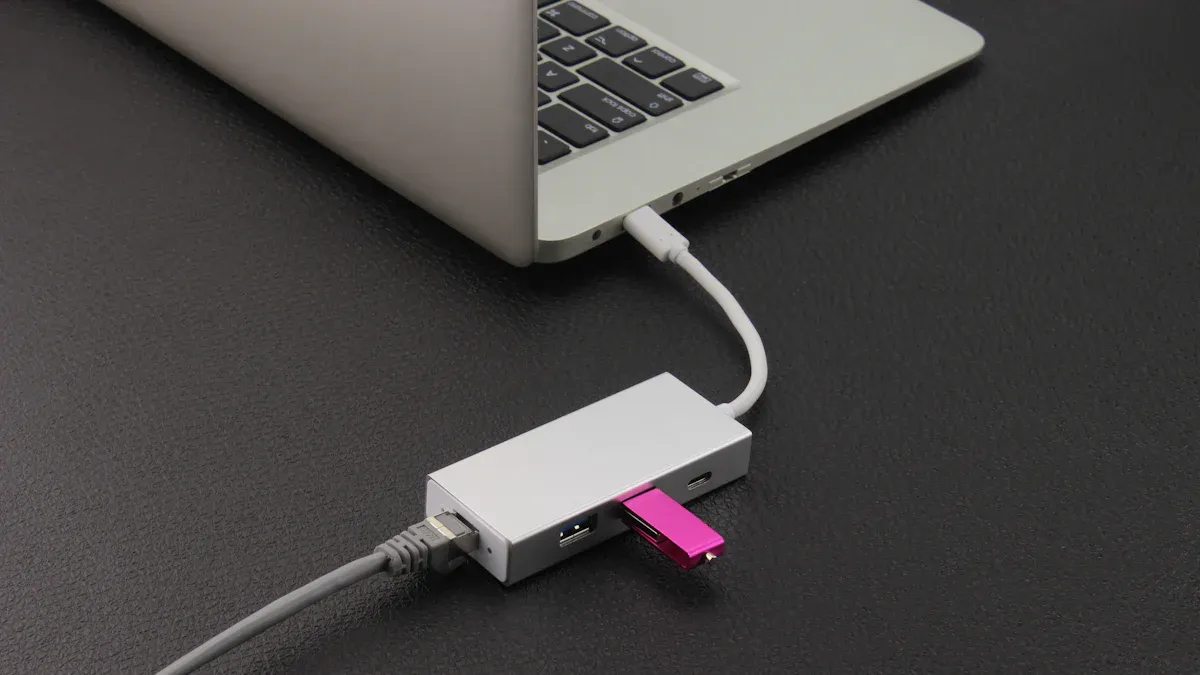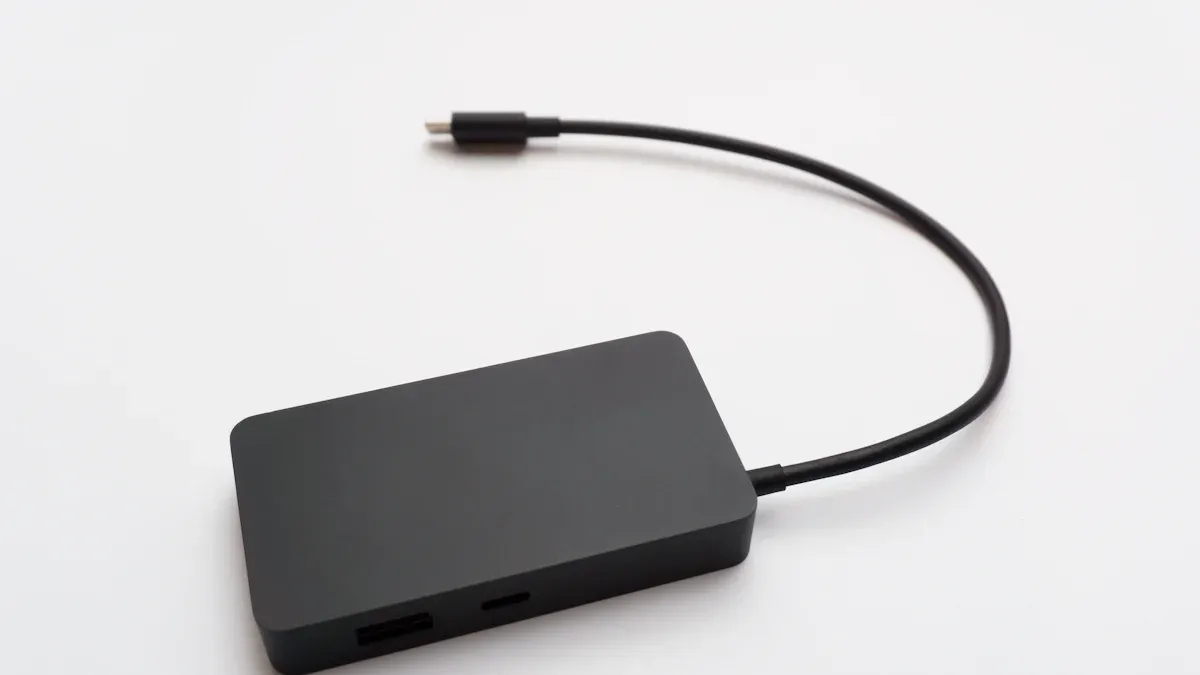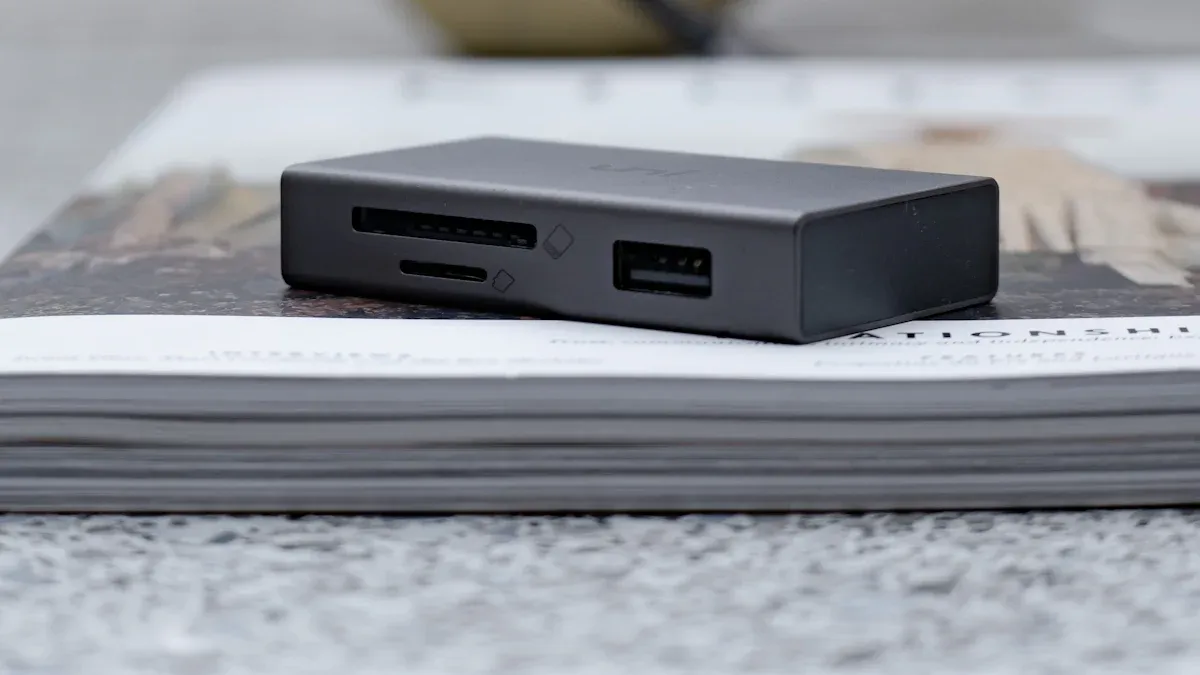SMSC USB2660/USB2660i Explained: USB 2.0 Hubs and Controllers

The USB has changed how devices connect and share data. USB 2.0 hubs help by letting many devices use one port. Flash media controllers move data between memory cards and computers, keeping things fast and smooth.
The SMSC USB2660/USB2660i combines these tools into one smart device. It works with fast data speeds and many memory card types, making it great for today’s needs. The USB market is growing from $35.34 billion in 2021 to $65.86 billion by 2028. Devices like the USB2660I-JZX-03 help meet this growing need.
Key Takeaways
The SMSC USB2660/USB2660i works as a USB hub and media controller. It helps devices connect and share data faster.
USB 2.0 lets data move quickly, up to 480 Mbps. This makes it great for modern gadgets and industrial tools.
The small size of the SMSC USB2660/USB2660i saves space. It is good for portable devices and built-in systems.
This device works with older USB 1.1 systems too. You can use it with old devices without big changes.
The USB2660i version is made for tough conditions. It works well in places like factories and vehicles.
Understanding USB 2.0 Architecture and Hubs

What Is USB 2.0 Architecture?
USB 2.0 made connecting devices faster and easier. It uses a host to control all connected devices. Data moves quickly at speeds up to 480 Mbits/s. The system uses four wires to send data and keep it accurate.
This design is flexible and can grow with more hubs. Hubs add extra ports, so more devices can connect. The USB Implementer’s Forum (USBIF) ensures all devices work well together.
Specification | Details |
|---|---|
Transfer Rate | Fast data transfer at 480 Mbits/s. |
Bus Topology | Host controls devices using a 4-wire system. |
Power Supply | Devices get power from the USB bus. |
Cable Length | Limited by signal strength and timing. |
Signaling | Uses D+ and D- wires for accurate data transfer. |
Protocol Standards | Rules set by the USB Implementer’s Forum (USBIF). |
Role of a Hub in USB 2.0 Systems
A USB hub connects the host to many devices. It makes sure each device gets enough data and power. Hubs are important for devices without their own power source.
External hubs add more ports for connecting devices. This is helpful for printers, drives, and other gadgets. Hubs handle lots of data while keeping the system stable.
Parameter | Min | Typ. | Max | Units |
|---|---|---|---|---|
USB Downstream Current | 0.0 | - | 2.5 | A |
System Efficiency | 84 | - | 86 | % |
Current Measurement Range | 6.4 | - | 2500 | mA |
Vbus Voltage Measurement | 0.0 | - | 5.5 | V |
Short Circuit Response Time | - | - | 1.5 | µs |
USB Downstream Vbus Current Supply (SDP mode) | - | - | 500 | mA |
Importance of the Root Hub in Device Connectivity
The root hub is the main part of USB 2.0. It connects the host to all devices and keeps data moving smoothly. It also sends power to devices and reduces delays.
Each hub is like a layer, with the root hub at the top. This setup helps devices work together easily. The root hub also identifies and sets up each device for proper use.
The root hub is key to keeping USB 2.0 systems working well. It ensures all devices get the data and power they need.

Flash Media Controllers and Their Role
What Are Flash Media Controllers?
Flash media controllers help manage data on flash memory devices. They work between the computer and the storage device. This ensures smooth communication and data handling. You can find them in USB drives, memory cards, and SSDs. Their main job is to control how data is read, written, and erased.
Modern controllers are made for different uses. Some work in simple devices like memory cards. Others handle heavy tasks in SSDs. Advanced controllers use many memory chips at once. This makes data transfer much faster. They also use wear leveling to make memory last longer. This spreads out writing evenly across all memory blocks.
How Flash Media Controllers Manage Data
Flash media controllers use smart methods to handle data. They prepare flash memory by marking bad cells and saving extra ones for later. A flash translation layer (FTL) helps store and find data efficiently.
Key tasks include garbage collection, which clears old data to make space. Wear leveling spreads out writing to avoid wearing out memory too soon. Bad-block management finds weak spots to prevent data loss. Overprovisioning saves extra space to improve writing speed. TRIM commands clean unused blocks, reducing the need for garbage collection.
Process | Description | Impact on Performance |
|---|---|---|
Garbage Collection | Clears old data to make space for new data. | Can slow down writing if not done well. |
Wear Leveling | Spreads writing evenly to avoid early damage. | May slow writing if not managed properly. |
Bad-Block Management | Finds weak spots to stop data loss. | Adds extra steps to reading and writing. |
Overprovisioning | Saves extra space to improve writing speed. | Helps devices work faster and better. |
TRIM/UNMAP Commands | Cleans unused blocks to free up space. | Reduces garbage collection, improving speed. |
Benefits of Flash Media Controllers in Modern Devices
Flash media controllers make devices work faster and better. They allow quicker data transfers and smarter storage management. Features like page mapping and FTL make them more advanced than older systems. For example, modern controllers are faster and more efficient, as shown below:
Feature | Modern Flash Media Controllers | Traditional Architectures |
|---|---|---|
Performance | Faster with page mapping | Slower with block mapping |
Efficiency | Smarter with FTL | Less efficient |
Metadata Size Ratio | 1:1000 for 1TB storage | Not mentioned |
These controllers also make flash memory last longer. They do this with wear leveling and bad-block management. Devices like USB drives benefit from these features. This makes them durable and reliable. Flash media controllers are now a key part of electronics, cars, and industrial systems.
Features of the SMSC USB2660/USB2660i

Overview of the SMSC USB2660/USB2660i
The SMSC USB2660/USB2660i is a smart device that combines a USB hub and a flash media controller. It uses USB 2.0 technology for fast data transfers up to 480 Mbps. This device improves how gadgets connect and share data. It works well in electronics, embedded systems, and industrial tools. Its small size and strong performance make it a great choice for modern needs.
The USB2660i version is made for tough industrial uses. It handles extreme temperatures and is built to last in harsh conditions. Both versions also work with older USB 1.1 devices, making them useful for many systems.
Key Features and Specifications
The SMSC USB2660/USB2660i has important features that make it special:
Integrated USB Hub: Connects many devices to one host easily.
Flash Media Controller: Moves data between memory cards and the host quickly.
High-Speed Mode: Uses USB 2.0 for fast and steady data sharing.
Backward Compatible: Works with older USB 1.1 gadgets.
Compact Design: Saves space, perfect for small or portable devices.
Industrial-Grade Durability: The USB2660i version works in extreme heat or cold.
Feature | Specification |
|---|---|
USB Version | USB 2.0 (Works with USB 1.1) |
Data Transfer Rate | Up to 480 Mbps |
Operating Temperature | -40°C to 85°C (USB2660i version) |
Supported Media Formats | SD, MMC, MS, xD |
Integration of USB 2.0 Hub and Flash Media Controller Functions
The SMSC USB2660/USB2660i combines a USB hub and a flash media controller in one device. This lets it do many jobs at once. The hub connects multiple devices to one host. The flash media controller manages data for memory cards. This design removes the need for extra parts, making systems simpler and better.
Its high-speed mode keeps data moving smoothly, even with many devices connected. It works with both USB 2.0 and older USB 1.1, making it flexible for different uses. By combining these two features, the SMSC USB2660/USB2660i saves space and money while improving performance.
Uses of the SMSC USB2660/USB2660i
Role in Everyday Electronics
The SMSC USB2660/USB2660i is important for everyday gadgets. It improves how laptops, desktops, and docking stations work by making connections easy. Its built-in hub lets many devices connect at once. This is great for printers, scanners, and media players. The flash media controller works with memory cards like SD and MMC, so it fits many devices.
The need for such devices is growing fast. In 2023, 39% of USB market money came from electronics. Asia-Pacific leads because of its high demand for gadgets. This shows how the SMSC USB2660/USB2660i helps meet modern tech needs.
Use in Industrial and Embedded Systems
Industrial and embedded systems use the SMSC USB2660/USB2660i a lot. Its strong build makes it reliable for industrial PCs and automation tools. The USB2660i version works in very hot or cold places. It gives steady USB storage, which is key for factories.
Its small size and fast data speeds make it great for tight spaces. By combining a hub and flash media controller, it saves space and money. This makes it useful for things like factory machines and data recording.
Use in Cars and Medical Tools
The SMSC USB2660/USB2660i is also used in cars and medical tools. In cars, it plays music, videos, and stores navigation data. It works with many memory card types, so it fits different media.
In healthcare, it helps store and move patient data safely. It’s used in medical machines and imaging tools where data must be accurate. The USB2660i version is tough, so it works well in hard conditions. It’s also used in security systems and data recording.
The USB market was worth $29.4 billion in 2023 and may hit $149.6 billion by 2032. This growth shows how USB tech, like the SMSC USB2660/USB2660i, is becoming more important.
Year | Market Size (USD Billion) | Growth (%) |
|---|---|---|
2023 | 32.28 | N/A |
2032 | 79.41 | 10.52 |
The SMSC USB2660/USB2660i is flexible and fits many needs. It works well in electronics, factories, cars, and medical tools.
Benefits of the SMSC USB2660/USB2660i
Faster Data Transfers and Better Connections
The SMSC USB2660/USB2660i speeds up data sharing. It combines a fast USB hub with a flash media controller. It can transfer data at speeds up to 480 Mbps. This makes it great for systems needing quick and steady communication, like multimedia tools or factory machines.
The hub lets many devices share data and power efficiently. Each device gets what it needs without slowing down others. This is helpful for setups with few USB ports, as it adds more connections while keeping speeds high.
It also improves connections by reducing delays and keeping communication stable. Managing many devices at once makes it useful for modern gadgets and embedded systems.
Small Size for Many Uses
The SMSC USB2660/USB2660i is small but powerful. Its compact design fits into tight spaces, making it perfect for portable gadgets and embedded systems. Even though it’s small, it handles fast data transfers and shares power well.
Its design removes the need for extra parts, making systems simpler. This is especially helpful for electronics where saving space matters. Devices like laptops, docking stations, and media players work better with it, as it connects easily without taking up much room.
Works with Many Devices and Systems
The SMSC USB2660/USB2660i works with both USB 2.0 and older USB 1.1 devices. This means it can be added to older systems without big changes. It connects to printers, scanners, and memory cards, making it useful for many tasks.
It supports different formats and devices, which is great for factories and cars. It also handles fast speeds for demanding systems, keeping everything running smoothly. This flexibility makes it a good choice for both home and industrial uses.
USB 2.0 hubs and flash media controllers have changed how devices connect. They make data sharing faster, more reliable, and easier to use. The SMSC USB2660/USB2660i combines these tools into one small, powerful device.
Main Points About USB 2.0 and SMSC USB2660/USB2660i:
Market Role: USB 2.0 is 60% of the market in 2023. It’s popular because it works well and costs less.
Tech Improvements:
Used in gadgets and computer accessories.
New USB 2.0 flash drives with better security features.
More ways to connect devices using USB 2.0 hubs.
Year | USB 2.0 Market Share | Key Features |
|---|---|---|
2023 | 60% | Works with many devices, fast, affordable |
The SMSC USB2660/USB2660i is flexible and dependable. It’s used in electronics, factories, and medical tools, showing its value in today’s tech world.
What makes the SMSC USB2660/USB2660i special?
The SMSC USB2660/USB2660i combines a USB hub and flash controller. It transfers data quickly, supports many memory cards, and is durable. Its small size and ability to work with USB 1.1 make it useful for many devices.
Can the SMSC USB2660/USB2660i work in extreme temperatures?
Yes, the USB2660i version is made for tough conditions. It works well in temperatures from -40°C to 85°C. This makes it great for factories, cars, and outdoor setups.
Which devices use the SMSC USB2660/USB2660i?
The SMSC USB2660/USB2660i improves laptops, desktops, and docking stations. It also helps printers, scanners, industrial PCs, and car systems. Its ability to handle many devices and memory cards makes it very useful.
Is the SMSC USB2660/USB2660i compatible with older USB devices?
Yes, it works with older USB 1.1 devices. This allows it to connect to older systems while still being fast for USB 2.0 devices. It’s flexible for both old and new setups.
How does the SMSC USB2660/USB2660i boost system performance?
This device improves performance by combining a USB hub and flash controller. It transfers data up to 480 Mbps, reduces delays, and keeps connections stable. Its design saves space and makes systems more reliable for many uses.
See Also
Choosing Between CYUSB3014-BZXI and CYUSB3014-BZXC Controllers
Three Key Features of SPC5605BMLL6 and SPC5607BMLL6 ECUs
SPC56 Microcontrollers: Simplified Solutions for Engine Control
Understanding MC9S12DJ256MFUE Specs for Automotive Use Cases
CALL US DIRECTLY
(+86)755-82724686
RM2508,BlockA,JiaheHuaqiangBuilding,ShenNanMiddleRd,Futian District,Shenzhen,518031,CN
www.keepboomingtech.com sales@keepboomingtech.com
